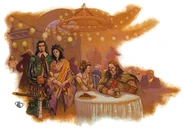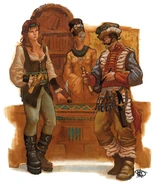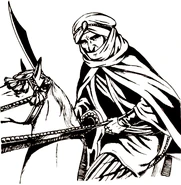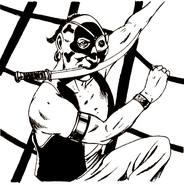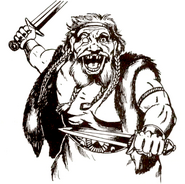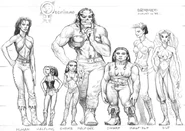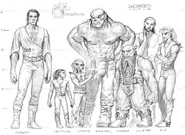Humans on Toril were widespread, could be found in most regions and, in general, were fierce and disagreeable, which could sometimes lead certain other races to view them with contempt. They were renowned for their diversity and ambition, and although they lacked specialization, they could excel in many areas.[2][10]
Etymology[]
Names for Humans[]
Many races had their own unique terminology by which they referred to humans. Elves and halfling were known to call them the manyhanded, in reference to an old elven insult the "Manyhanded Curse," while orcs referred to them as the brittle bones. Brownies, halflings, korreds, and satyrs were all known to use the term hurbryn, meaning "heavy-footed." Treants referred to humans as oroosh, meaning "never-stopping-talkers."[12] Dragons referred to them as munthrek[13] and in the Giant language they were known as van.[14][15]
Ethnicities[]
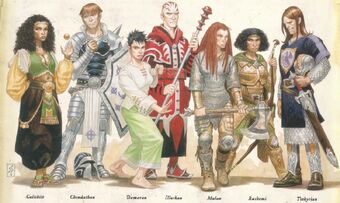
A Calishite, Tethyrian, Damaran, Mulan, Illuskan, Rashemi, and Chondathan.[note 2]
There was great ethnic diversity between humans in different regions.[16]
Faerûn[]
The following were the most prevalent and largest ethnic groups to be found in Faerûn during the last two millennia of the Age of Humanity continuing into the Era of Upheaval. They were by far the most common ethnicities found within the Heartlands of Faerûn.[17]
- Calishites: These dark-skinned folk were plentiful in Southwest Faerûn[18] and were descended from the human slaves of the genie lords of Calimshan.[17]
- Chondathans: Although these humans spread across the Western Heartlands, their lineage could be traced back to the natives of the Vilhon Reach.[19]
- Damarans: The prideful and headstrong people that settled around the Sea of Fallen Stars were living remnants of ancient Narfell.[19]
- Illuskans: A proud, fair-skinned sea-faring people who hailed from the Sword Coast North.[19]
- Mulan: The humans of east Faerûn predominantly belonged to this ethnic group, a fact they held with much pride and arrogance.[19]
- Rashemi: A hardy and easily adaptable people, descended from the nomadic Raumathar who eventually settled in Aglarond, Rashemen and Thay.[19][20]
- Tethyrians: Perhaps the most tolerant and independent groups of humans in Faerûn, these people were a melting pot of other ethnicities and greatly varied in appearance.[20]
Kara-Tur[]
- Issacortae, the shamanistic people of the kingdom in wild, western region of the Ama Basin[21]
- Koryoan, these proud and exuberant descendants of the Han lived in the Koryo Peninsula[22]
- Kozakuran, islanders of the Kozakura archipelago[23]
- Kuong, citizens of the jungle kingdom who spoke their own distinct language[24]
- Shou, one of the more influential ethnic groups that were found in the continent of Kara-Tur[25]
- Wanese, the ethnic people of the islands of Wa[26]
- Wu-haltai, the agrarian people of the eastern Ama Basin[27]
Maztica[]
The native Mazticans lived on a continent west of the Trackless Sea.
- Azuposi, the matrilineal tribes of the Pasocada Basin[28]
- Green Folk, the short and dexterous people from the southern jungles[29]
- Metahel, a tribe of sea-faring humans from central Maztica[30]
- Nahopaca, hunter-gatherers of the central Pasocado Basin[30]
- Nexalans, a warring people from the Valley of Nexal in central Maztica[31]
- North Ones, desert-dwelling savage nomads from the northern wastes of Maztica[32]
- Payit, the proud and industrious tribe from Far Payit[33]
Minor ethnic groups[]
The following are ethnic groups which were either small in number, or who were most commonly found in lands far from Faerûn's heartlands. In their own distinct regions, they might very well be the major local ethnic people.[20]
- Abbalayar, a group of humans who lived within a secluded city on Mount Abbalayat, within the Marching Mountains of Calimshan.[34]
- Arkaiun, the stout and dusky-skinned humans of Dambrath and Halruaa[10]
- Bavanese and Bertanese, the island inhabitants of Bawa and Bertan in Kara-Tur[35]
- Bawani, an ethnic group also native to the island of Bawa[35]
- Bedine, dark-skinned folk of North Faerûn[10] who were once nomads of Anauroch[20]
- Chultans, tribal folk that lived in the eponymous jungle[20]
- Durpari, the swarthy followers of the Adama along the coasts of the Golden Water[20][36]
- Ffolk, the darker-skinned seafarers of the southern Moonshae Isles[20][37]
- Gurs, the nomadic descendants of the Rashemi that lived in the Western Heartlands[38][39]
- Halruaans, decedents of Netheril that settled in the Shining South[40]
- Imaskari, a people whose ancestors hailed from the fabled Old Imaskar[40]
- Itzas, an offshoot of the Payit people who lived in relative peace and serenity[41]
- Lantanna, the copper-skinned worshipers of Gond[40]
- Nars, nomadic tribes of traders from the grasslands east of the Giantspire Mountains[39][40]
- Netherese, the pure-blood remnants of the ancient civilization were scattered across Faerûn[25]
- Northlanders, the war-ready sea-faring people of the northern Moonshae Isles[42]
- Nubari, a tall and brown-skinned shamanistic tribe of the Malatran Plateau[43][44]
- Raumvirans, the descendants of the Raumviran Empire settled along the coast of the Lake of Mists[25]
- Pazruki, shepherding tribes who hailed from the Koryaz Mountains[27]
- Purang, Kara-turans native to the land of Purang in Malatra[24]
- Shaarans, the darks-skinned nomadic hunters of the Shaar[25][39]
- Sossrim, a silver-haired people who lived in the frozen lands near the Great Glacier
- Tashalans, people that escaped the bondage of the Sarrukh[45]
- Tuigan, the 15 nomadic tribes that wandered the vast Hordelands between Faerûn and Kara-Tur[45][46]
- Turami, the displaced population that settled in the land of Turmish[25]
- Ulutiuns, an ethnic group of tribal Kara-Tur who traveled across the north pole of Toril to the Endless Ice Sea[45][46]
- Vaasans, descendants of Netheril that settled around the Moonsea region[45]
Some ethnic groups were no longer present on Toril:
- Han, an ancient people of Kara-Tur that were nearly wiped out by the eruption of the Kanko volcano[47]
- Talfir, a long-past group of people who lived alongside the elves in the Western Heartlands during the times of the Crown Wars[25][45]
- Tayanulchi, this tribe from the Ama Basin disappeared into the Land of the Snow Demons[48]
Other ethnic groups of humans were referred to by the continent on which they lived:
- Zakharans: A shorter, dark-skinned people who rarely left their homelands on the continent of Zakhara.[49]
Related races[]
While natural subraces of humans were rare, a few did exist with either natural or unnatural origins and were considered as such because of unique biological or magical quirks not common to most humans, such as the skulk,[50] abbalaya,[51] and elans.[52] Humans bred outside their race many times, resulting in the various half-human races like half-elves[53] and half-orcs[54] as well as planetouched such as aasimars, genasi, and tieflings.[55][56]
History[]
The origin of humanity was unknown. Although the Tel-quessir could claim the primal war between Corellon and Gruumsh for their heritage and the dwarves claimed to have been forged from the rocks of Abeir-Toril itself, humans had no unifying creation myth. However, they were certainly an ancient race, having originated since before written records existed and were frequently considered one of the creator races, though they weren't known to have actually created any species. More confusing yet was that, while humans indeed were native to Toril, they had been found on other worlds as well, with the Mulani standing out as an example of human immigrants to Toril.[57]
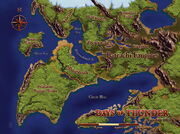
A map of Merrouroboros c. −31,500 DR, showing the land occupied by humans in the south-west.
During the Days of Thunder (−35,000 DR to −30,000 DR) on the supercontinent of Merrouroboros, humans were a primitive race, similar to apes. Tribes of humans largely inhabited the land later known as the continent of Katashaka. They used simple tools, banged rocks together to make fire, and dwelled in caves. According to Bazim-Gorag, a batrachi (another of the creator races) they hid in caves in fear—he called them "Meat".[58]
Regardless of their precise origins, humans were undeniably successful. While hardly the only dominant race of Toril, humans were one of them and the most recent to obtain dominance. In spite of this strength, or perhaps because of it, humanity was an eternally fractured and divided race, broken up into over a dozen ethnic offshoots. It was believed that this was in part because humanity, unlike most other races, did not emerge as a whole but rather in several places at once, thereby resulting in its diversity.[59]
Appendix[]
| This article is incomplete. You can help the Forgotten Realms Wiki by providing more information. |
Notes[]
- ↑ The appearance of humans in the Realms varied wildly. The values here present a general range. For the full diversity of skin colors, hair colors, eye colors, hairstyles, and builds, see the individual entries for the many human ethnicities presented in the navigation box at the bottom of this article.
- ↑ The caption in the Player's Guide to Faerûn is incorrect. Chondathan was switched with Tethyrian and Mulan was switched with Illuskan.
Appearances[]
- Adventures
- Hoard of the Dragon Queen • Rise of Tiamat • Tomb of Annihilation • Storm King's Thunder • Baldur's Gate: Descent into Avernus • Icewind Dale: Rime of the Frostmaiden
- Novels
- Avatar series • Return of the Archwizards • The Fanged Crown • Honor Among Thieves: Heroes Unite! • Honor Among Thieves: The Druid's Call • Honor Among Thieves: The Quest Begins
- Comics
- Legends of Baldur's Gate • Shadows of the Vampire • Frost Giant's Fury • Evil at Baldur's Gate • Infernal Tides • At the Spine of the World • Mindbreaker • Honor Among Thieves: The Feast of the Moon
- Board Games
- Dungeons & Dragons: Bedlam in Neverwinter
Gallery[]
External Links[]
Disclaimer: The views expressed in the following links do not necessarily represent the views of the editors of this wiki, nor does any lore presented necessarily adhere to established canon.
 Human article at the Dark Sun Wiki, a wiki for the Dark Sun campaign setting.
Human article at the Dark Sun Wiki, a wiki for the Dark Sun campaign setting. Human article at the Dragonlance Wiki, a wiki for the Dragonlance campaign setting.
Human article at the Dragonlance Wiki, a wiki for the Dragonlance campaign setting. Human article at the Eberron Wiki, a wiki for the Eberron campaign setting.
Human article at the Eberron Wiki, a wiki for the Eberron campaign setting. Human article at the Baldur's Gate 3 Community Wiki, a community wiki for Baldur's Gate 3.
Human article at the Baldur's Gate 3 Community Wiki, a community wiki for Baldur's Gate 3. Human article at the Baldur's Gate Wiki, a wiki for the Baldur's Gate games.
Human article at the Baldur's Gate Wiki, a wiki for the Baldur's Gate games. Humans article at the Greyhawk Wiki, a wiki for the Greyhawk campaign setting.
Humans article at the Greyhawk Wiki, a wiki for the Greyhawk campaign setting. Human article at the Spelljammer Wiki, a wiki for the Spelljammer campaign setting.
Human article at the Spelljammer Wiki, a wiki for the Spelljammer campaign setting.
References[]
- ↑ Jeff Grubb and Ed Greenwood (1990). Forgotten Realms Adventures. (TSR, Inc). ISBN 0-8803-8828-5.
- ↑ 2.0 2.1 2.2 2.3 2.4 2.5 Mike Mearls, Jeremy Crawford (2014). Player's Handbook 5th edition. (Wizards of the Coast), pp. 29–31. ISBN 978-0-7869-6560-1.
- ↑ 3.0 3.1 3.2 3.3 Rob Heinsoo, Andy Collins, James Wyatt (June 2008). Player's Handbook 4th edition. (Wizards of the Coast), pp. 46–47. ISBN 0-7869-4867-1.
- ↑ Mike Mearls, Stephen Schubert, James Wyatt (June 2008). Monster Manual 4th edition. (Wizards of the Coast), pp. 162–163. ISBN 978-0-7869-4852-9.
- ↑ 5.0 5.1 Jonathan Tweet, Monte Cook, Skip Williams (July 2003). Player's Handbook v.3.5. (Wizards of the Coast), pp. 12–14. ISBN 0-7869-2886-7.
- ↑ Doug Stewart (June 1993). Monstrous Manual. (TSR, Inc), pp. 196–199. ISBN 1-5607-6619-0.
- ↑ Nigel Findley (September 1991). Into the Void. (TSR, Inc.), p. 51. ISBN ISBN 1-56076-154-7.
- ↑ Mike Mearls, Jeremy Crawford (2014). Player's Handbook 5th edition. (Wizards of the Coast), p. 121. ISBN 978-0-7869-6560-1.
- ↑ Jonathan Tweet, Monte Cook, Skip Williams (July 2003). Player's Handbook v.3.5. (Wizards of the Coast), p. 109. ISBN 0-7869-2886-7.
- ↑ 10.0 10.1 10.2 Steve Kenson, et al. (November 2015). Sword Coast Adventurer's Guide. Edited by Kim Mohan. (Wizards of the Coast), p. 110. ISBN 978-0-7869-6580-9.
- ↑ 11.0 11.1 Ed Greenwood, Sean K. Reynolds, Skip Williams, Rob Heinsoo (June 2001). Forgotten Realms Campaign Setting 3rd edition. (Wizards of the Coast), p. 10. ISBN 0-7869-1836-5.
- ↑ Ed Greenwood (October 2012). Ed Greenwood Presents Elminster's Forgotten Realms. (Wizards of the Coast), p. 12. ISBN 0786960345.
- ↑ Andy Collins, James Wyatt, and Skip Williams (November 2003). Draconomicon: The Book of Dragons. (Wizards of the Coast), p. 29. ISBN 0-7869-2884-0.
- ↑ Ray Winninger (September 1995). Giantcraft. Edited by Karen S. Boomgarden. (TSR, Inc.), p. 28. ISBN 0-7869-0163-2.
- ↑ Mike Mearls, et al. (November 2016). Volo's Guide to Monsters. Edited by Jeremy Crawford, et al. (Wizards of the Coast), p. 20. ISBN 978-0786966011.
- ↑ Ed Greenwood, Sean K. Reynolds, Skip Williams, Rob Heinsoo (June 2001). Forgotten Realms Campaign Setting 3rd edition. (Wizards of the Coast), p. 18. ISBN 0-7869-1836-5.
- ↑ 17.0 17.1 Richard Baker, James Wyatt (March 2004). Player's Guide to Faerûn. (Wizards of the Coast), p. 10. ISBN 0-7869-3134-5.
- ↑ Mike Mearls, Jeremy Crawford (2014). Player's Handbook 5th edition. (Wizards of the Coast), p. 30. ISBN 978-0-7869-6560-1.
- ↑ 19.0 19.1 19.2 19.3 19.4 Richard Baker, James Wyatt (March 2004). Player's Guide to Faerûn. (Wizards of the Coast), p. 16. ISBN 0-7869-3134-5.
- ↑ 20.0 20.1 20.2 20.3 20.4 20.5 20.6 Richard Baker, James Wyatt (March 2004). Player's Guide to Faerûn. (Wizards of the Coast), p. 17. ISBN 0-7869-3134-5.
- ↑ Mike Pondsmith, Jay Batista, Rick Swan, John Nephew, Deborah Christian (1988). Kara-Tur: The Eastern Realms (Volume I). (TSR, Inc), p. 91. ISBN 0-88038-608-8.
- ↑ Mike Pondsmith, Jay Batista, Rick Swan, John Nephew, Deborah Christian (1988). Kara-Tur: The Eastern Realms (Volume II). (TSR, Inc), p. 120. ISBN 0-88038-608-8.
- ↑ Thomas M. Costa (1999). “Speaking in Tongues”. In Dave Gross ed. Dragon Annual #4 (TSR, Inc) (4)., p. 26.
- ↑ 24.0 24.1 Mike Pondsmith, Jay Batista, Rick Swan, John Nephew, Deborah Christian (1988). Kara-Tur: The Eastern Realms (Volume II). (TSR, Inc), p. 99. ISBN 0-88038-608-8.
- ↑ 25.0 25.1 25.2 25.3 25.4 25.5 Reynolds, Forbeck, Jacobs, Boyd (March 2003). Races of Faerûn. (Wizards of the Coast), p. 108. ISBN 0-7869-2875-1.
- ↑ Mike Pondsmith, Jay Batista, Rick Swan, John Nephew, Deborah Christian (1988). Kara-Tur: The Eastern Realms (Volume II). (TSR, Inc), p. 172. ISBN 0-88038-608-8.
- ↑ 27.0 27.1 Mike Pondsmith, Jay Batista, Rick Swan, John Nephew, Deborah Christian (1988). Kara-Tur: The Eastern Realms (Volume I). (TSR, Inc), p. 92. ISBN 0-88038-608-8.
- ↑ John Nephew and Jonathan Tweet (April 1992). City of Gold. (TSR, Inc), p. 8. ISBN 978-1560763222.
- ↑ Douglas Niles (August 1991). “A Journey to the True World”. Maztica Campaign Set (TSR, Inc.), p. 49. ISBN 1-5607-6084-2.
- ↑ 30.0 30.1 John Nephew and Jonathan Tweet (April 1992). City of Gold. (TSR, Inc), p. 9. ISBN 978-1560763222.
- ↑ Douglas Niles (August 1991). “A Journey to the True World”. Maztica Campaign Set (TSR, Inc.), p. 51. ISBN 1-5607-6084-2.
- ↑ Douglas Niles (August 1991). “A Journey to the True World”. Maztica Campaign Set (TSR, Inc.), p. 52. ISBN 1-5607-6084-2.
- ↑ Douglas Niles (August 1991). “A Journey to the True World”. Maztica Campaign Set (TSR, Inc.), pp. 50–51. ISBN 1-5607-6084-2.
- ↑ Steven E. Schend, Dale Donovan (September 1998). Empires of the Shining Sea. Edited by Julia Martin. (TSR, Inc.), pp. 85–86. ISBN 0-7869-1237-5.
- ↑ 35.0 35.1 Mike Pondsmith, Jay Batista, Rick Swan, John Nephew, Deborah Christian (1988). Kara-Tur: The Eastern Realms (Volume II). (TSR, Inc), pp. 110–111. ISBN 0-88038-608-8.
- ↑ Reynolds, Forbeck, Jacobs, Boyd (March 2003). Races of Faerûn. (Wizards of the Coast), p. 111. ISBN 0-7869-2875-1.
- ↑ Ed Greenwood, Jeff Grubb (August 1987). “Cyclopedia of the Realms”. In Karen S. Martin ed. Forgotten Realms Campaign Set (TSR, Inc.), p. 64. ISBN 0-88038-472-7.
- ↑ Reynolds, Forbeck, Jacobs, Boyd (March 2003). Races of Faerûn. (Wizards of the Coast), p. 106. ISBN 0-7869-2875-1.
- ↑ 39.0 39.1 39.2 Steve Kenson, et al. (November 2015). Sword Coast Adventurer's Guide. Edited by Kim Mohan. (Wizards of the Coast), p. 111. ISBN 978-0-7869-6580-9.
- ↑ 40.0 40.1 40.2 40.3 Reynolds, Forbeck, Jacobs, Boyd (March 2003). Races of Faerûn. (Wizards of the Coast), p. 107. ISBN 0-7869-2875-1.
- ↑ Douglas Niles (August 1991). “A Journey to the True World”. Maztica Campaign Set (TSR, Inc.), p. 50. ISBN 1-5607-6084-2.
- ↑ Ed Greenwood, Sean K. Reynolds, Skip Williams, Rob Heinsoo (June 2001). Forgotten Realms Campaign Setting 3rd edition. (Wizards of the Coast), p. 148. ISBN 0-7869-1836-5.
- ↑ Stephen H. Jay, Robert Farnsworth (January 2000). Living Jungle Campaign: Player Information Guide (PDF). Living Jungle (RPGA), p. 3.
- ↑ Stephen H. Jay, et al. (January 2003). Inhabitants of the Jungle (PDF). Edited by Stephen Gryphon. Living Jungle (RPGA), p. 16.
- ↑ 45.0 45.1 45.2 45.3 45.4 Reynolds, Forbeck, Jacobs, Boyd (March 2003). Races of Faerûn. (Wizards of the Coast), p. 109. ISBN 0-7869-2875-1.
- ↑ 46.0 46.1 Steve Kenson, et al. (November 2015). Sword Coast Adventurer's Guide. Edited by Kim Mohan. (Wizards of the Coast), p. 112. ISBN 978-0-7869-6580-9.
- ↑ Mike Pondsmith, Jay Batista, Rick Swan, John Nephew, Deborah Christian (1988). Kara-Tur: The Eastern Realms (Volume II). (TSR, Inc), p. 118. ISBN 0-88038-608-8.
- ↑ Mike Pondsmith, Jay Batista, Rick Swan, John Nephew, Deborah Christian (1988). Kara-Tur: The Eastern Realms (Volume I). (TSR, Inc), pp. 93–95. ISBN 0-88038-608-8.
- ↑ Reynolds, Forbeck, Jacobs, Boyd (March 2003). Races of Faerûn. (Wizards of the Coast), p. 110. ISBN 0-7869-2875-1.
- ↑ David Noonan et al. (December 2004). Races of Destiny. (Wizards of the Coast), pp. 105–107. ISBN 0-7869-3653-3.
- ↑ Richard Baker, Ed Bonny, Travis Stout (February 2005). Lost Empires of Faerûn. Edited by Penny Williams. (Wizards of the Coast), pp. 116–117. ISBN 0-7869-3654-1.
- ↑ Bruce R. Cordell (April 2004). Expanded Psionics Handbook. (Wizards of the Coast), p. 16. ISBN 0-7869-3301-1.
- ↑ Reynolds, Forbeck, Jacobs, Boyd (March 2003). Races of Faerûn. (Wizards of the Coast), p. 59. ISBN 0-7869-2875-1.
- ↑ Reynolds, Forbeck, Jacobs, Boyd (March 2003). Races of Faerûn. (Wizards of the Coast), p. 67. ISBN 0-7869-2875-1.
- ↑ Reynolds, Forbeck, Jacobs, Boyd (March 2003). Races of Faerûn. (Wizards of the Coast), p. 125. ISBN 0-7869-2875-1.
- ↑ Ed Greenwood, Sean K. Reynolds, Skip Williams, Rob Heinsoo (June 2001). Forgotten Realms Campaign Setting 3rd edition. (Wizards of the Coast), p. 20. ISBN 0-7869-1836-5.
- ↑ Reynolds, Forbeck, Jacobs, Boyd (March 2003). Races of Faerûn. (Wizards of the Coast), p. 80. ISBN 0-7869-2875-1.
- ↑ Brian R. James, Ed Greenwood (September 2007). The Grand History of the Realms. Edited by Kim Mohan, Penny Williams. (Wizards of the Coast), pp. 5, 6. ISBN 978-0-7869-4731-7.
- ↑ Rob Heinsoo, Andy Collins, James Wyatt (June 2008). Player's Handbook 4th edition. (Wizards of the Coast), p. 46. ISBN 0-7869-4867-1.
Connections[]
Maztica: Azuposi • Dog People • Green Folk • Metahel • Nahopaca • Nexalan • Payit (Itza)
Taan: Commani, Dalat, Fankiang, Gur, Guychiang, Igidujin, Kashghun, Khassidi, Naican, Oigur, Pazruki, Quirish, T'aghur, Tsu-tsu, Tuigan, Zamogedi
Kara-Tur & Malatra: Bavanese & Bertanese • Bawani • Han • Issacortae • Koryoan • Kozakuran • Kuong • Nubari (Huroola • Koshiva • Kukalatu • Wise Ones • Zantira) • Pazruki • Purang • Seng • Shou • Tabotan • Tayanulchi • Wanese • Wu-haltai
Zakhara: Zakharan

